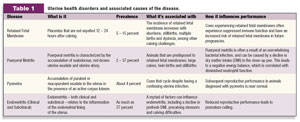Successfully navigating the transition period can be difficult on many accounts. Maintaining dry matter intake (DMI), adapting to social challenges and bypassing potential metabolic disorders that loom postpartum can cause cows to struggle in the milking string. Knowing how to identify uterine health problems and understanding the financial implications of uterine health disorders allows for more effective treatment and reduced incidence in the herd.
Defining uterine diseases
Multiple diseases can affect the dairy cow postpartum. These diseases are more likely to occur in cows with uterine infection caused by various types of bacteria and retained fetal membranes. By understanding the variety of diseases that influence uterine health, we can better understand how to prevent and treat such diseases to ensure optimal reproductive performance.
The long-term effects of uterine health
Metritis is regarded as one of the most widespread and costly uterine health disorders and has a negative impact on milk production, reproductive performance and on-farm profits.
Research has been conducted to determine what prepartum behaviors may predict metritis. One study tracked DMI two weeks prepartum through 21 days in milk (DMI) and found cows with severe metritis ate less than healthy animals throughout the transition period ( Table 1 ). 
• Cows were 1.72 times more likely to be diagnosed with severe metritis for every 10-minute decrease in feeding time during the week before calving.
• For every 2.2-pound decrease in DMI, cows were nearly three times more likely to be diagnosed with severe metritis.
• This may indicate a social system where subordinate individuals are given less time to feed, leading to health problems.
Metritis also influenced milking string performance. The same study concluded that when cows calved, metritis negatively impacted production potential. The average daily milk production was 18.3 pounds per day less for the severely metritic and 12.6 pounds per day less for the mildly metritic cows, compared to the cows that remained healthy throughout three weeks after calving.
This research confirmed that a social component may exist in the incidence of metritis. Because cows that experienced severe metritis postpartum spent less time eating, it may indicate a social order where subordinate cows do not eat for the proper amount of time each day.
What’s uterine health worth to your dairy?
Research presented new data on the direct and indirect costs associated with metritis. Research from the 1980s estimated metritis to cost about $106 per case; revised numbers from over two decades later show that the costs may be much higher.
The study identified four major areas that metritis negatively impacts:
• Reduced milk production
Cows diagnosed with metritis produced 15.1 pounds less milk per day in the first 30 days in milk (DIM). At $14 milk, the resulting loss is $60 per case of metritis.
• Increased culling risk
Cows with metritis are more likely to leave the herd within the first 60 DIM, resulting in a cost of $75 per case.
• Decreased reproductive performance
A total of 73 percent of normal cows became pregnant and maintained the pregnancy for the entire lactation compared to only 59 percent for the cows with metritis. When 21-day pregnancy rate decreased by 4.5 points, the result was a financial loss of $81 per case.
• Additional treatment costs
Depending on drug utilization and discarded milk, the cost can vary from $50 to $94 per case.
The total cost of metritis in a herd can reach $300 per diagnosed case. On a 2,000-cow dairy with an incidence of 30 percent, the effects of metritis alone can reach above $180,000 annually.
Moving ahead on uterine health
The costs associated with lost production, reduced reproductive performance and additional treatment show just how critical it is to reduce incidence of uterine diseases on the dairy. Use these tips to evaluate and improve your herd’s uterine health.
• Maintain dry matter intake.
Almost all uterine health disorders are linked to a drop in DMI prior to calving. While it’s almost inevitable that intake will decline as calving approaches, work to keep cows eating as much as you can prior to calving. The closer cows are to maintaining intake, the less susceptible they are to immune depression and, therefore, uterine health challenges.
• Monitor animals closely.
As research confirms, animals that are more susceptible to uterine health disorders often show a change in behavior before calving, including less time at the feedbunk or not fighting other animals for space during eating. Watch animals closely to identify ones that are more prone to poor performance postpartum.
• Calculate your costs.
Knowing how much uterine health is costing your dairy can help gauge where improvements can be made and just how much these diseases are impacting your profit margins. Once you have calculated how much uterine health costs your dairy, continue to routinely monitor this number to identify improvements or potential challenges, and make adjustments as necessary.
• Work with your veterinarian for improvement.
Your veterinarian can provide insight on ways to ensure cows enter the milking string reproductively sound. When challenges arise, turn to your veterinarian to help identify opportunities to make improvements and keep cows healthy.
To ensure reproductive performance is optimized, it’s critical to focus on uterine health throughout the transition period and beyond. Keeping cows healthy through the calving process is essential for future success in the breeding pen. PD
References omitted due to space but are available upon request by sending an email to editor@progressivedairy.com.
— Excerpts from Dairy Cattle Reproduction Council Newsletter, Vol. 3, No. 6






